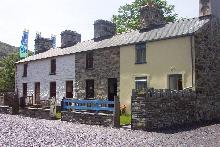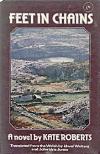|
|
|
Communities - Homes
Prosperous towns and villages developed in the wake of
the slate industry, and by the 1850's Local Boards were set up, as at
Bethesda in 1854. By that year Bethesda consisted of 1,242 houses, 60 shops
and 27 public houses situated on the High Street. The male population of the
village was 3,011 compared to 1,744 females. Local building societies were
formed to enable quarrymen to buy their own property. Others, of course, were
content to pay rent. |
 |
| The village of Rhosgadfan was built on
common land, and when people started to work in the quarries they
enclosed a section of the land to build their own cottages to live
in…By 1826, 140 cottages had been built and three chapels. In these
rent free dwellings with a garden 700 people lived, with a garden and
enough land to keep a cow…As far as the houses are concerned, they
were very very small, simple storey buildings, a dairy, two bed
chambers and a loft. One or two still stand today practically
unchanged since the day they were built. In those days the feet of
wainscot beds were the walls between the bed chambers and kitchen but
in time that was changed when a partition of wood was built. Each had
an inglenook fireplace wide enough for an armchair. I am not old
enough to remember the old fashioned fireplace and the earth floor but
the peat hole underneath the inglenook was still there in my youth and
it was ideal to air clothes. By my days we had a grate with a small
oven on one side with a boiler and a tap on it to hold water on the
other. On the other side of the boiler was the large oven which
extended almost a yard into the wall and you could lay a fire
underneath it. It took a lot of coal to heat up the oven, but then you
could bake a good number of loaves. Once the oven was up to
temperature very little coal was needed to keep it going. |
|
(Y Lôn Wen, pages 26-27)
|
Remembering tales of earliest times Kate Roberts recalled: |
| |
A
At that time there wasn't a house there worth calling a ho use: a
house was only four walls and a thatched roof. There was a peat fire
on the floor and two wooden beds. When someone died you had to sleep
in the same place as the coffin. use: a
house was only four walls and a thatched roof. There was a peat fire
on the floor and two wooden beds. When someone died you had to sleep
in the same place as the coffin.
(Feet in Chains, page 16)
Jane rested in her own mind she knew that working in the quarry and
running a small-holding was too much for him. But what was to be done?
She had heard enough about the quarries to know how uncertain were the
wages; and it was a wonderful thing to have plenty of milk and butter.
One thing troubled her greatly - that was the condition of the house.
The kitchen was the only comfortable room. The bedrooms, especially
the back one, were damp and quite unhealthy for anyone to sleep in.
The dampness ran down the walls, spoiling the paper, and water dropped
on to the bed from the wooden ceiling during the frosty weather. She
would like to have a new part built alongside the old house so that
she would at least have a good parlour and two bedrooms. There were
enough stones on Ffridd felen to build such an extension, and getting
rid of the stones would improve the land. But Ifan would have to blast
the stones and that would be more work for him.
|
|
(Feed in Chains, page 21-22)
|
|
| |
Quarrymen's wives
For some interesting reason no doubt, O.M. Edwards did not have a good word to say about quarrymen's wives from
Caernarfonshire. As he travelled down by train towards south Wales in 1891 he wrote:
| `There was a
quarryman's wife there follwing her husbands down to the workings with
her sister and four children. The children were the most squirmish I
ever saw…They told me that they were going to Glamorganshire to settle
for good, and leaving Arfon…why do quarrymen's wives dress so grandly
and why is their grandness so tasteless. The clothes of both of them
showed two inconsistent facts vanity of dress and poorness of dress.
They had bought the most fashionable of clothes over the years, with
every cut being utterly ridiculous; they had mixed up all the fashions
without any attempt at order and taste; the the grand clothes by now
looked very shabby. Notice a gathering of quarrymen in Arfon on a
Sunday, and you would imagine yourself to be amongst the most
fashionable gathering in Paris; walk through the village on a Monday
morning and you would think you were walking through the lowest slum
in London, where everbody has got their clothes from the second hand
shop.' |
|
(Tro i'r De, O.M. Edwards, page 61-63.)
|
|
| |
| |
|
|
|
|
|